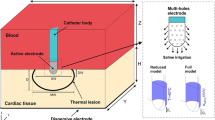Abstract
Finite element (FE) analysis has been utilised as a numerical tool to determine the temperature distribution in studies of radio frequency (RF) cardiac ablation. However, non of the previous FE analyses clarified such computational aspects as software requirements, computation time or convergence test. In addition, myocardial properties included in the previous models vary greatly. A process of FE modelling of a system that included blood, myocardium, and an ablation catheter with a thermistor embedded at the tip is described. The bio-heat equation is solved to determine the temperature distribution in myocardium using a commercial soft-ware application (ABAQUS). A Cauchy convergence test (∈=0.1°C) was performed and it is concluded that the optimal number of elements for the proposed system is 24610. The effects of changes in myocardial properties (±50% electric conductivity, +100%/−50% thermal conductivity, and +100%/−50% specific heat capacity) in both power-controlled (PCRFA) and temperature-controlled RF ablation (TCRFA) were studied. Changes in myocardial properties affect the results of the FE analyses of PCRFA more than those of TCRFA, and the maximum changes in lesion volumes were −58.6% (−50% electric conductivity), −60.7% (+100% thermal conductivity), and +43.2% (−50% specific heat).
Similar content being viewed by others
References
Bhavaraju, N. C., andValvano, J. W. (1999): ‘Thermophysical properties of swine myocardium’,Int. J. Thermophys.,20, pp. 665–676
Edwards, S. D., andStern, R. A. (1997): ‘Electrode and associated systems using thermally insulated temperature sensing elements’. US Patent 5,688,266
Elvan, A., Pride, P., Eble, J. N., andZipes, D. (1995): ‘Radiofrequency catheter ablation of the atria reduces inducibility and duration of atrial fibrillation in dogs’,Circulation,91, pp. 2235–2244
Forster, K. R., andSchwan, H. P. (1989): ‘Dielectric properties of tissues and biological materials: a critical review’,CRC Crit. Rev. Biomed. Eng.,17, pp. 25–104
Haines, D. E. (1993): ‘The biophysics of radiofrequency catheter ablation in the heart: the importance of temperature monitoring’,PACE,16, pp. 586–591
Haines, D. E., andWatson, D. D. (1989): ‘Tissue heating during radiofrequency catheter ablation: a thermodynamic model and observation in isolated perfused and superfused canine right ventricular free wall’,PACE,12, pp. 962–976
Haïssaguere, M., Shah, D. C., Jaïs, P., Chauvin, M., Hocini, M., Garrigue, S., Peng, J. T., Fuimaono, K., Pyke, R., andClementy, J. (2000): ‘Circular multipolar pulmonary vein catheter for mapping guided minimal ablation of atrial fibrillation’,PACE,23 (part II), p. 574
Huang, S. K. S., andWilber, D. J. (Eds) (2000): Radiofrequency catheter ablation of cardiac arrhythmias: basic concepts and clinical applications, 2nd Edn' (Futura Publishing Company, Armonk, New York)
Kaouk, Z., Shahidi, A. V., Savard, P., andMolin, F. (1996a): ‘Modelling of myocardial temperature distribution during radio-frequency ablation’,Med. Biol. Eng. Comput.,34, pp. 165–170
Kaouk, Z., Khebir, A., andSavard, P. (1996b): ‘A finite element model of microwave catheter for cardiac ablation’,IEEE Trans.,MTT-44, pp. 1848–1854
Labonté, S. (1994): ‘A computer simulation of radio-frequency ablation of the endocardium’,IEEE Trans.,BME-41, pp. 883–890
Labonté, S. (1994): ‘Numerical model for radio-frequency ablation of the endocardium and its experimental validation’,IEEE Trans.,BME-41, pp. 108–115
Nath, S., Lynch, C., III, Whayne, J. G., andHaines, D. E. (1993): ‘Cellular electrophysiological effects of hyperthermia on isolated Guinea pig papillary muscle: Implications for catheter ablation’,Circulation,88 (Part 1), pp. 1826–1831
Panescu, D. (1997): ‘Intraventricular electrogram mapping and radio-frequency cardiac ablation for ventricular tachycardia’,Physiol. Meas.,18, pp. 1–38
Panescu, D., Fleischman, S. D., Whayne, J. G., Swanson, D. K., Mirotznik, M. S., Mcrury, I., andHaines, D. E. (1999): ‘Radio-frequency multielectrode catheter ablation in the atrium’,Phys. Med. Biol.,44, pp. 899–915
Panescu, D., Whayne, J. G., Fleischman, D., Mirotznik, M. S., Swanson, D. K., andWebster, J. G. (1995): ‘Three-dimensional finite element analysis of current density and temperature distributions during radio-frequency ablation’,IEEE Trans.,BME-42, pp. 870–890
Shahidi, A. V., andSavard, P. (1994): ‘A finite element model for radio-frequency ablation of the myocardium’,IEEE Trans.,BME-41, pp. 963–968
Tungjitkusolmun, S., Cao, H., Tsai, J.-Z., andWebster, J. G. (1997): ‘Using ANSYS for three-dimensional electrical-thermal models for radio-frequency catheter ablation’ Proc. 19th Ann. Int. Conf. IEEE Eng. Med. Biol. Soc. Chicago (IEEE Piscataway, NJ) pp. 161–164
Valvano, J. W., Cochran, J. R., andDiller, K. R. (1985): ‘Thermal conductivity and diffusivity of biomaterials measured with self-heated thermistors’,Int. J. Thermophys.,6, pp. 301–311
Zipes, D. P. (1994): ‘Catheter ablation of arrhythmias’ (Futura Publishing Company, Armonk, New York)
Author information
Authors and Affiliations
Corresponding author
Rights and permissions
About this article
Cite this article
Tungjitkusolmun, S., Woo, E.J., Cao, H. et al. Thermal—electrical finite element modelling for radio frequency cardiac ablation: Effects of changes in myocardial properties. Med. Biol. Eng. Comput. 38, 562–568 (2000). https://doi.org/10.1007/BF02345754
Received:
Accepted:
Issue Date:
DOI: https://doi.org/10.1007/BF02345754




